Non-toxic mosquito traps offer an eco-friendly alternative to harmful chemical sprays. You’ll need simple household items like a plastic bottle, sugar, water, and yeast to create effective DIY traps. Place them in shaded areas around your property, especially near potential breeding sites, and maintain them weekly for best results. These traps target female mosquitoes without harming beneficial insects or putting your family at risk. Discover how strategic placement and proper timing can dramatically reduce your local mosquito population.
Understanding Mosquito Behavior and Breeding Cycles
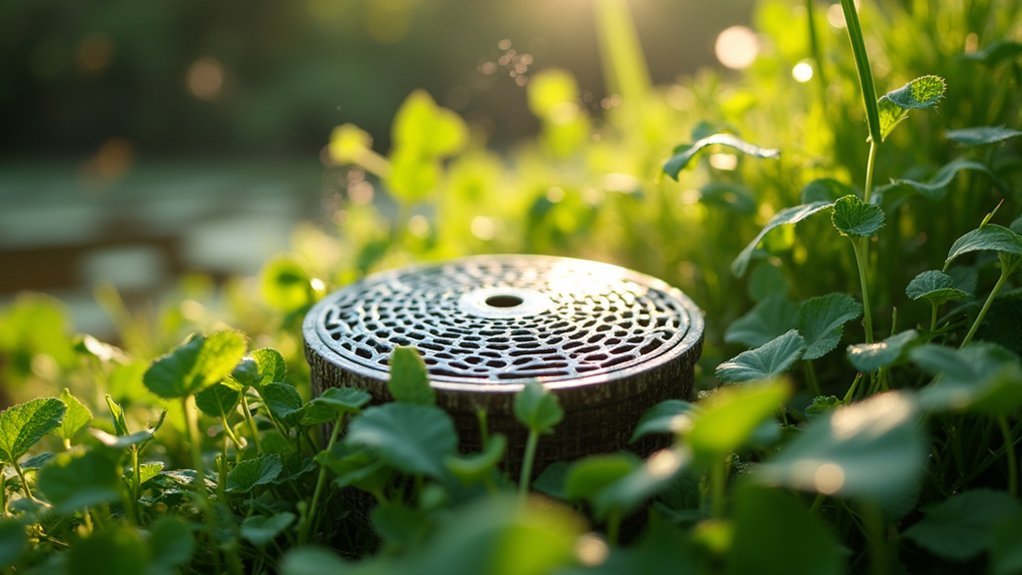
To effectively control mosquitoes without harmful chemicals, you’ll need to understand what makes these persistent pests tick.
Female mosquitoes lay eggs in standing water—even tiny amounts can become a breeding ground for mosquitoes. Their life cycle from egg to adult takes just 10-14 days under favorable conditions, allowing populations to explode quickly.
From egg to buzzing pest in less than two weeks—no wonder mosquitoes seem to appear overnight in your yard.
You’ll notice mosquitoes are most active during cooler evening hours. They’re attracted to you by the carbon dioxide you exhale and your skin odors. During the day, they seek shelter in vegetation and shaded areas.
To reduce the mosquito population in your yard, eliminate standing water in flowerpots, gutters, and bird baths.
With over 150 species in the U.S., understanding their breeding cycles is your first defense against these disease vectors.
Why Choose Non-Toxic Options Over Chemical Solutions
While chemical mosquito treatments might seem like a quick fix, they come with serious drawbacks that make non-toxic alternatives far superior.
Commercial sprays typically kill only 10% of mosquitoes while simultaneously harming beneficial insects and biodiversity in your yard.
Non-toxic mosquito traps, particularly CDC-designed autocidal gravid ovitraps, specifically target mosquitoes without collateral damage to other species. This makes them a truly environmentally friendly option for effective control.
Additionally, chemical solutions contain pyrethroids that pose health risks to your pets and wildlife.
For thorough protection, consider microbial larvicides like Bacillus thuringiensis israelensis (Bti), which specifically target mosquito larvae in standing water.
DIY Sugar-Yeast Mosquito Trap Construction Guide
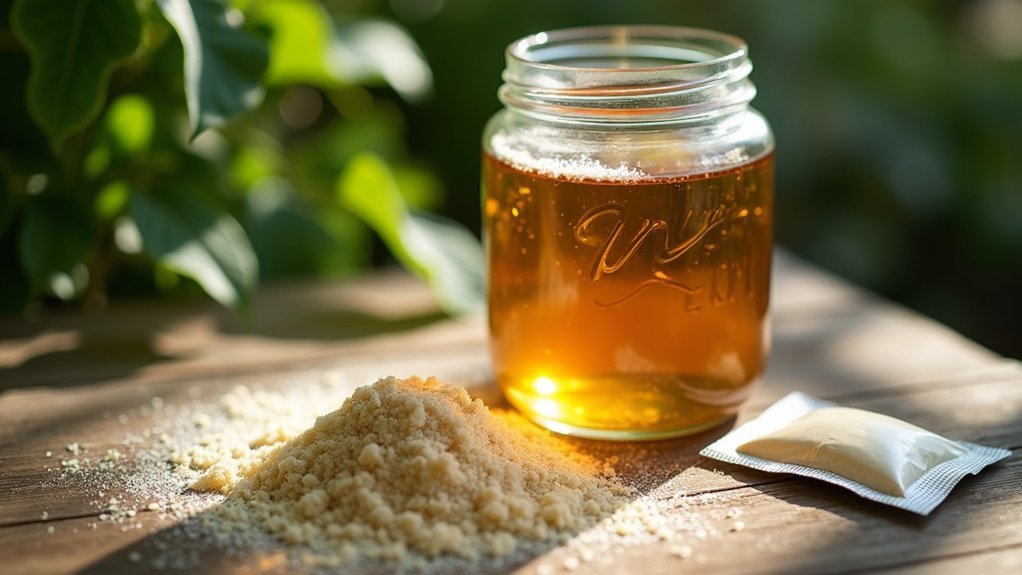
Creating an effective mosquito trap at home doesn’t require expensive materials or complicated steps. This DIY mosquito trap uses a simple sugar-yeast mixture to attract mosquitoes through carbon dioxide production—the same gas that draws them to humans.
- Mix 1 cup sugar with 1 cup water, heat until dissolved, then cool before adding 1 teaspoon of active dry yeast.
- Cut the top off a two-liter plastic bottle and invert it to create a funnel entrance.
- Pour your mixture into the bottle—mosquitoes can enter but won’t escape.
- Place traps in shaded, damp areas where mosquitoes congregate.
For ideal capture rates, replace your mixture every few weeks or when the trap becomes full.
This non-toxic control method provides a chemical-free alternative that’s safe for families while effectively reducing mosquito populations.
Water-Based Mosquito Traps: Setup and Maintenance
Water-based mosquito traps effectively capture breeding females by mimicking natural stagnant water environments they’re instinctively drawn to.
You’ll need to place these DIY traps in shaded, windless areas near existing mosquito hotspots, filling them with water and appropriate larvicides or biological controls.
Clean your trap solutions weekly by emptying, rinsing, and refilling with fresh water to prevent the growth of unwanted organisms while maintaining ideal mosquito-attracting conditions.
DIY Stagnant Water Traps
Clever homeowners can easily create effective mosquito control systems using simple stagnant water traps. These DIY stagnant water traps utilize one-gallon containers filled with water and Mosquito Dunks containing Bacillus thuringiensis israelensis (Bti) to kill mosquito larvae without harming beneficial insects.
To create your own traps and reduce mosquito populations:
- Fill containers with water and add Mosquito Dunks according to package instructions.
- Place traps in shaded areas where mosquitoes typically breed.
- Check traps weekly, replacing water and ensuring Bti remains effective.
- Position multiple traps strategically around your property for extensive coverage.
Each Mosquito Dunk remains effective for about 30 days, providing continuous control measures.
Cleaning Trap Solutions
Maintaining your water-based mosquito traps requires regular cleaning to confirm they continue to attract and capture mosquitoes effectively. Change the water weekly to prevent larvae development while guaranteeing peak performance of your trap system.
| Maintenance Task | Frequency | Benefits |
|---|---|---|
| Water replacement | Weekly | Prevents breeding |
| Add Bti larvicide | During refill | Kills developing larvae |
| Clean trap surface | Bi-weekly | Maintains attractiveness |
| Inspect sticky components | Monthly | Confirms capture effectiveness |
For best results, use a mixture of fresh water and Bti larvicide when refilling your traps. This combination enhances mosquito control while preventing organic matter buildup that might deter mosquitoes. Don’t forget to remove debris from trapping surfaces and replace capture nets when they become clogged or damaged.
Effective Placement Strategies for Homemade Traps

Strategic placement of your homemade mosquito traps can dramatically increase their effectiveness in reducing the pesky insects around your home. For truly effective mosquito control, position your traps thoughtfully throughout your property.
- Seek shaded areas where mosquitoes rest during daylight hours – under bushes, beneath deck overhangs, or along fence lines provide ideal locations.
- Target standing water sources by placing traps near ponds, bird baths, or drainage areas where mosquitoes breed.
- Space traps 10-15 feet apart to prevent competition between them and maximize your coverage area.
- Install near gathering spaces such as patios or entry points where you need the most protection.
Remember to regularly check and maintain your homemade traps, replacing attractants as needed for continuous mosquito reduction.
Natural Attractants That Lure Mosquitoes Effectively
You’ll find that carbon dioxide is one of the most powerful mosquito attractants, mimicking human breath and drawing these pests toward your trap.
Adding heat elements to your trap creates a signature similar to warm-blooded animals, which mosquitoes instinctively seek for blood meals.
These natural lures work together to dramatically increase your trap’s effectiveness without introducing toxic chemicals into your environment.
Carbon Dioxide Mimics
When female mosquitoes search for their next blood meal, they’re instinctively drawn to the carbon dioxide we exhale with every breath.
Modern mosquito traps leverage this biological fact by using carbon dioxide mimics to attract and capture these disease-spreading insects.
These sophisticated control methods work by:
- Replicating the exact CO₂ signature that signals “human host nearby” to hungry female mosquitoes
- Combining heat and moisture elements that further simulate human presence
- Continuously emitting attractants through propane or electric systems to cover large areas
- Creating an irresistible lure that diverts mosquitoes away from you and your family
Research shows that strategically placed carbon dioxide traps can notably reduce mosquito populations across entire neighborhoods, making them an effective component in your non-toxic mosquito management strategy.
Heat Signature Lures
How effectively can heat alone draw mosquitoes to a trap? Remarkably well, as these bloodsuckers naturally home in on the warmth of potential hosts. Heat signature lures capitalize on this behavior, mimicking the body temperatures that mosquitoes find irresistible.
Research confirms that non-toxic mosquito traps incorporating heat technology capture considerably more mosquitoes than those without this feature. You’ll find these systems particularly valuable in residential settings, where they target species attracted to human presence.
For maximum effectiveness, look for passive traps that combine heat signature lures with other attractants like carbon dioxide or moisture.
The beauty of this approach lies in its simplicity: by replicating a mosquito’s natural target—your body heat—these traps provide effective control without chemical repellents, making them a smarter choice for environmentally conscious pest management.
Light-Based Trapping Methods for Nighttime Control
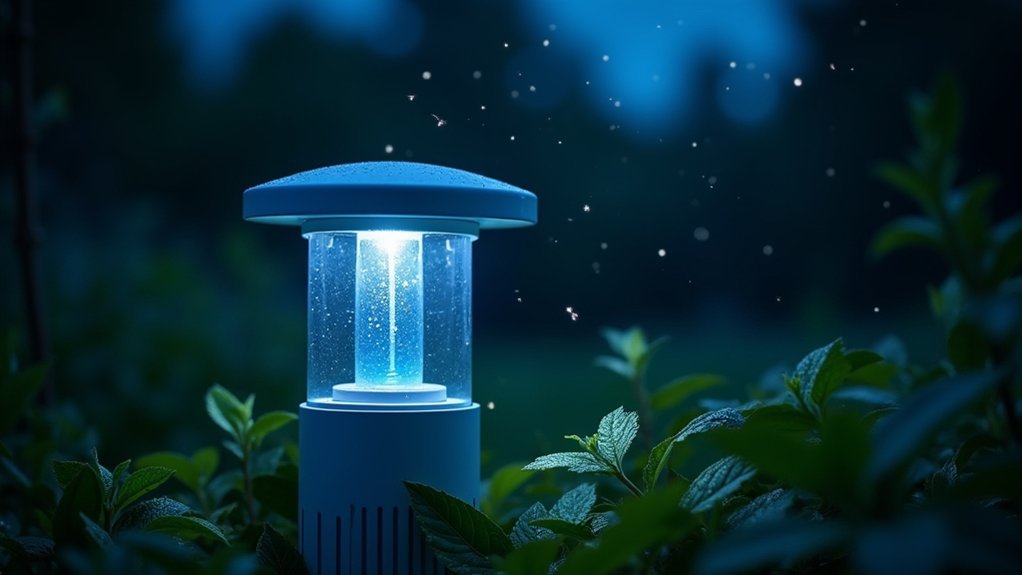
Since mosquitoes become particularly active after sunset, light-based traps offer an effective solution for nighttime mosquito control without toxic chemicals.
These specialized devices attract insects using UV light that’s irresistible to nocturnal mosquitoes when they’re most active.
UV light acts as an irresistible beacon for night-hunting mosquitoes, drawing them in when they’re most persistent.
How light-based mosquito traps work to protect your outdoor spaces:
- They emit UV light that draws mosquitoes in, often combined with carbon dioxide to mimic human breath.
- Built-in fans vacuum mosquitoes into collection chambers once they approach the light source.
- Sticky surfaces or containers trap and contain the pests for easy disposal.
- When strategically placed, they reduce mosquito populations considerably.
For best results, use these traps as part of an integrated pest management approach that includes eliminating standing water where mosquitoes breed.
Combining Traps With Habitat Modification Techniques
Maximizing the effectiveness of non-toxic mosquito traps requires a thorough approach that combines trapping with strategic habitat modifications.
By deploying CDC-designed autocidal gravid ovitraps while simultaneously eliminating standing water, you’ll target both adult mosquitoes and their breeding sites.
Inspect your property regularly for potential breeding spots like clogged gutters and water-collecting containers. Remember, female mosquitoes need water to lay eggs.
For non-drainable water sources, introduce mosquito-eating fish in ornamental ponds and keep bird baths clean.
Focus your habitat modification efforts within a 300-foot radius of your home, as many mosquito species don’t travel far from where they hatch.
This integrated pest management approach creates a detailed control system that’s more environmentally friendly and effective than relying solely on chemical pesticides.
Seasonal Considerations for Trap Deployment
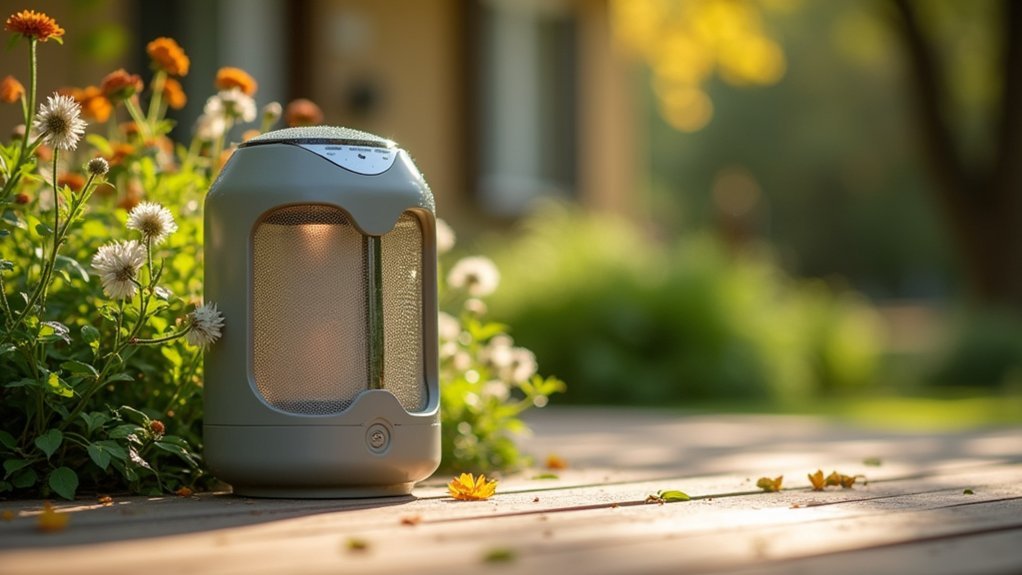
Timing plays a critical role in the effectiveness of your non-toxic mosquito control strategy. Deploy your traps in early spring when temperatures consistently reach 50°F, before mosquitoes begin breeding in large numbers.
Since mosquitoes develop from egg to adult in just 10-14 days, early intervention prevents population explosions.
- Spring Setup – Install traps as temperatures warm to 50°F to catch the first breeding wave
- Maintenance Schedule – Inspect and refresh trap components every few weeks to maintain peak performance
- Weather Adaptations – Deploy traps earlier following mild winters or periods of heavy rainfall
- Seasonal Positioning – Relocate traps to shadier areas during summer months when mosquitoes seek cooler environments
Remember that local climate patterns affect mosquito activity, so adjust your seasonal control approach accordingly.
Monitoring and Measuring Your Trap’s Effectiveness
Once you’ve set up your non-toxic mosquito traps, strategically place them near gathering areas and potential breeding sites to maximize their effectiveness.
Count captured mosquitoes weekly, noting changes in volume that might indicate seasonal patterns or trap performance issues.
Learning basic mosquito species identification can help you target specific threats, as different species carry different diseases and respond to various trap types.
Trap Placement Strategy
Strategic placement of your mosquito traps can dramatically improve their effectiveness in reducing local mosquito populations. Your trap placement strategy should focus on locations that naturally attract mosquitoes, maximizing your chances of capture and control.
- Position traps in shaded areas near known breeding sites like standing water, as adult mosquitoes are naturally drawn to these cooler, humid environments.
- Adjust placement based on mosquito species—Aedes prefer traps near water sources while Culex are attracted to vegetated areas.
- Create a neighborhood-wide approach by collaborating with neighbors to establish a strategic trap network that reduces the entire local population.
- Monitor weekly and relocate traps if necessary, tracking capture rates to determine the most effective locations in your specific environment.
Counting Captured Mosquitoes
To determine whether your non-toxic mosquito trap is actually making a difference, you’ll need to implement a systematic approach to counting and tracking your catches. Establish a consistent schedule—daily or weekly counts work best—to create reliable data for evaluating your mosquito control efforts.
| Tracking Element | Purpose |
|---|---|
| Count Frequency | Establishes baseline for mosquito population trends |
| Weather Notes | Correlates environmental factors with trap performance |
| Location Changes | Tests effectiveness of different placements |
| Breeding Site Removal | Documents impact of habitat elimination |
Mark captured mosquitoes with a permanent marker if you’re testing multiple trap locations. This helps you identify which strategies most effectively reduce mosquito populations. Remember to document any environmental changes you make, such as eliminating standing water or other breeding sites, as these actions will impact your trap’s catch numbers.
Species Identification Techniques
Proper mosquito species identification empowers you to select the most effective control strategies for your specific pest problem.
Different species have varied breeding habits, preferred habitats, and disease transmission potential, making accurate identification essential for targeted control.
To identify mosquito species in your traps:
- Use a magnifying glass to examine key physical features like wing patterns, leg markings, and proboscis structure.
- Photograph specimens and utilize mobile apps or online identification guides for visual comparison.
- Contact local mosquito control districts for assistance with challenging identifications.
- Document species data alongside trap locations to map breeding sources and population distributions.
This information helps you adjust your control strategies based on the specific mosquito populations in your area, maximizing your trap effectiveness and minimizing breeding sources.
Complementary Natural Repellents for Complete Protection
Why rely solely on traps when nature offers additional layers of mosquito defense? For maximum effectiveness, pair your non-toxic traps with complementary natural repellents. Essential oils from citronella, eucalyptus, and lavender work synergistically with traps to disrupt mosquito attraction patterns.
Embrace nature’s complete mosquito solution—traps enhanced with botanical repellents create an impenetrable defense system.
Your outdoor spaces can become mosquito-resistant zones by incorporating aromatic plants like marigolds, rosemary, and basil. Their strong scents naturally deter these pests while beautifying your yard.
Consider applying apple cider vinegar mixtures or garlic spray solutions around your property for additional protection.
For thorough mosquito control, combine these natural approaches with passive traps like autocidal gravid ovitraps. This integrated strategy targets both adult mosquitoes and their larvae, creating a complete defense system that’s effective without introducing harmful chemicals into your environment.
Troubleshooting Common DIY Trap Problems
Even well-designed homemade mosquito traps can encounter performance issues that reduce their effectiveness. When your trap isn’t attracting mosquitoes as expected, consider these common problems:
- Poor placement – Your trap should be in shaded areas where mosquitoes gather, not in direct sunlight or windy locations that deter them from approaching.
- Ineffective attractants – Replace sugar-yeast mixtures regularly, as their potency decreases over time, making your trap less appealing to mosquitoes.
- Improper water management – Maintain suitable levels of stagnant water to attract female mosquitoes for egg-laying, but check for leaks that might drain your trap.
- Location issues – If you’re not catching mosquitoes, relocate your trap closer to breeding sites where mosquito activity is highest, particularly near standing water sources.
Frequently Asked Questions
Why Was Thermacell Discontinued?
Thermacell was discontinued because you’re part of a growing market that’s demanding eco-friendly mosquito solutions. The company’s responding to your preference for products that don’t harm beneficial insects and pollinators.
What Does the CDC Recommend for Mosquito Repellent?
The CDC recommends you use EPA-registered insect repellents containing DEET, picaridin, oil of lemon eucalyptus, or IR3535. You’ll need to reapply after swimming, sweating, or prolonged outdoor activities for continued protection.
What Is the Best Natural Mosquito Control?
The best natural mosquito control combines eliminating standing water, using Bti in unavoidable water sources, planting repellent plants like citronella and lavender, and setting up passive traps like Biogents GAT around your property.
How Do You Get Rid of Mosquitoes Without Harming Pollinators?
To get rid of mosquitoes without harming pollinators, you’ll want to use passive traps like Biogents GAT, apply Bti in standing water, eliminate breeding sites, attract natural predators, and follow integrated pest management practices.
In Summary
You’ve now got all the tools to implement safe, non-toxic mosquito control in your environment. By understanding mosquito behavior and using these DIY traps strategically, you’ll reduce populations without harmful chemicals. Remember to adjust your approach seasonally, monitor results, and complement traps with natural repellents. With consistent application of these methods, you’ll enjoy a more comfortable outdoor space while protecting your family’s health.

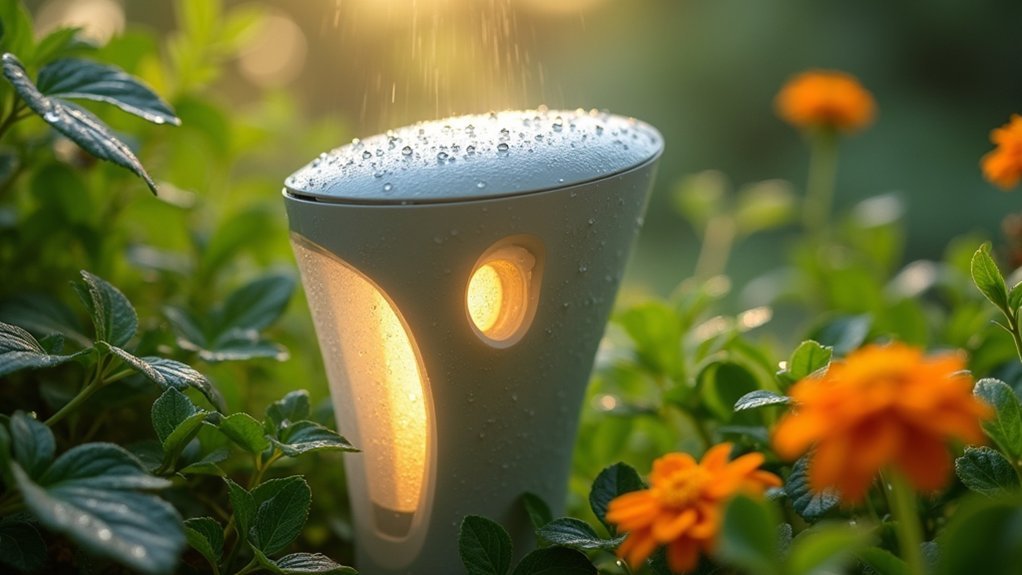



Leave a Reply